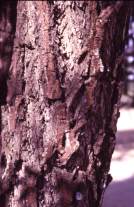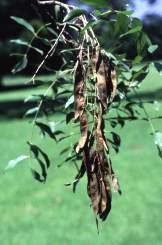Bolusanthus speciosus
Bolusanthus speciosus (Bolus) Harms
Family: Fabaceae
Common names: tree wisteria; Vanwykshout (Afr.); mogaba (Northern Sotho); umHolo (Zulu) National tree list no.: 222
SA Tree No: 222
Introduction
The tree wisteria is certainly one of the most spectacular of our indigenous trees when in flower, mimicking the splendour of the jacaranda, which unfortunately is proving to be an invader species in parts of South Africa. Given time and effort this tree could replace the jacaranda trees from Argentina and carpet Pretoria streets with indigenous purple blooms instead.

Description
Description

This decorative, small to medium-sized tree is deciduous, dropping its leaves only for a short period in early spring. The tree is normally multi-stemmed, but it can be pruned to form a single stem. The bark of the stem is brownish grey, rough and deeply fissured. Leaves, which are spirally arranged, are suspended from drooping branches.

The drooping, blue-mauve, fragrant, pea-like flowers hang from the branches in bunches, often covering the whole tree. Flowering time is from August to January (spring and early summer). Flowers are followed by papery, brown fruit pods, that hang from the branches in clusters, and never split to release their seeds. Being a protected tree in South Africa, wild specimens may not be removed, cut down or damaged.
Distribution and habitat
Distribution description
Bolusanthus speciosus is widespread in wooded grasslands in southern Africa, from Angola and Zambia down to KwaZulu-Natal.
Derivation of name and historical aspects
History
Bolusanthus honours Harry Bolus (1834 to 1911), who was a South African botanist and founder of the Cape Town Bolus Herbarium; speciosus means beautiful or showy in Latin.
Uses
Use
The wood, which is highly sought after by carpenters, makes excellent furniture. It works well on a lathe, turning out beautiful lampshades and other articles. The straight growing stems are very hard, termite resistant and used for fencing posts. The roots are used medicinally to alleviate stomach problems and the inner bark used to treat abdominal cramps. It also has excellent potential as a tree for landscaping and growing in the home garden.
Growing Bolusanthus speciosus
Grow

Planted alongside a group of Bauhinia galpinii with striking red flowers, Bolusanthus speciosus is a sight to behold. It is an ideal tree to grace a medium to small garden, as it never grows too big. It can be grown in a container and looks spectacular on any sunny patio. As mentioned earlier, the tree wisteria makes a beautiful street tree with its non-invasive root system. To propagate place the seeds in hot water and soak overnight. Sow the seeds in containers filled with river sand, covering lightly with finer sand. Remember that the sowing depth should not be deeper than the diameter of the seed. The seeds germinate quickly and can be transplanted after the second leaf has emerged. A good soil mixture would be equal parts of river sand, loam and compost. With good care this tree can grow up to 800 mm per year.
Bolusanthus speciosus can withstand moderate frost, but will need protection for the first few years. It can also survive periods of drought.
References
- GERMISHUIZEN, G. & FABIAN, A. 1997. Wildflowers of northern South Africa. Fernwood Press, Vlaeberg, Cape Town.
- POOLEY, E. 1993. The complete field guide to trees of Natal, Zululand and Transkei. Natal Flora Publications Trust, Durban.
- SCHMIDT, E., LOTTER, M. & McCLELAND, W. 2002. Trees and shrubs of Mpumalanga and Kruger National Park. Redhotmoondog Communications & Jacana, Johannesburg.
- VENTER, F. & VENTER, J-A. 1996. Making the most of indigenous trees. Briza Publications, Pretoria.
Credits
Nick Klapwijk
Pretoria National Botanical Garden
April 2003
Plant Attributes:
Plant Type: Tree
SA Distribution: Gauteng, KwaZulu-Natal, Limpopo, Mpumalanga
Soil type: Sandy, Clay, Loam
Flowering season: Spring
PH: Neutral
Flower colour: Blue, Mauve/Lilac
Aspect: Full Sun
Gardening skill: Easy
Special Features:
Horticultural zones










Rate this article
Article well written and informative
Rate this plant
Is this an interesting plant?
Login to add your Comment
Back to topNot registered yet? Click here to register.